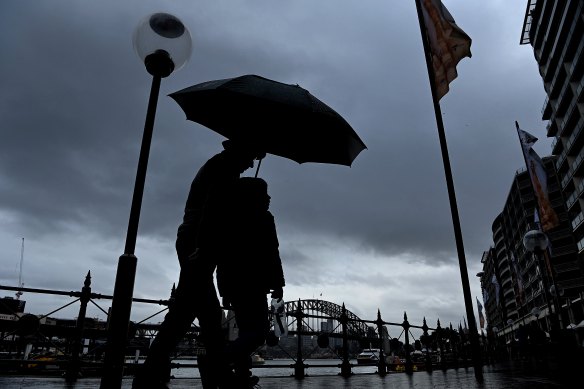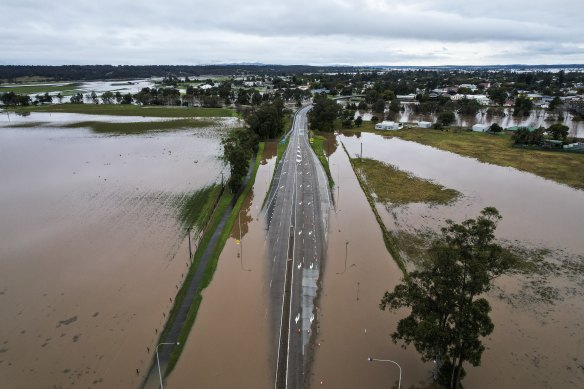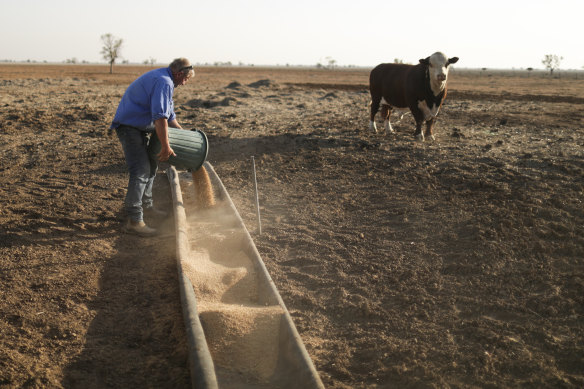If you haven’t heard the news, you must be living under an umbrella. La Nina is back, and she’s not done with us yet.
The Bureau of Meteorology told us earlier this week a La Nina event was under way, which means we’re set to be smashed by more rain and cooler temperatures over the next few months.
We’ve been here before. It’s our third La Nina in as many years.

Australia’s east coast in for another wet few months.Credit:Kate Geraghty
So after two years of historic floods, and rained-out events, is summer cancelled? Again? Well, not quite ... but don’t put away the wellington boots just yet. Let us explain.
First, the good news: it’s unlikely to be as bad as the last two.
Third time’s the charm, right? The first and second La Ninas over the summers of 2020-21 and 2021-22 brought significant rainfall to south-east Australia in particular, and caused flooding in NSW and Queensland.
This time, the Bureau of Meteorology expect a weaker event than the previous two. That’s because ocean temperatures – the main indicator of La Nina – are generally not as cold. There are different measurements that weather agencies use to measure it, but all indicate the Pacific won’t be as cold – meaning we can expect the effects of the cycle to be slightly weaker than earlier ones.
What’s more, it might be over quicker. A key detail in the Bureau of Meteorology’s information gives us some hope of a regular summer. “Models indicate this La Nina event may peak during the spring and return to neutral conditions early in 2023.” So at least the second half of summer won’t be as heavily impacted by it.
The arrows on the dials indicate the combined average of monthly outlooks from a survey of international global climate models.Credit:Bureau of Meteorology
There’s also the negative Indian Ocean Dipole (IOD) and the Southern Annular Mode, two other climate drivers to Australia’s west and south, which are compounding the wet weather. It’s pretty rare to see all three interact together.
“Most of the time, we only get one La Nina year and then it swings back [to neutral],” explains BOM forecaster Jake Phillips.
“In the eastern part of Australia, we should prepare for more rain than average in spring and the first half of summer.”
These forces aren’t looking as strong as they have been for the last two seasons of La Nina, suggesting the season will be both weaker, and shorter-lived.
So, will La Nina bring more floods?
Remember, La Nina generally means more rain for Australia (but not everywhere: in the US it means very dry conditions). That rain needs to go somewhere. With so much during La Nina, there’s always a greater risk of flooding but what’s particularly concerning is we’ve had two years of flooding events, compounding the effect.
As Carlene York from the NSW SES explains, “There is already wet soil, high rivers and full dams right across our state, and with more rain on the horizon comes the very real possibility of flooding.”

Flooding over much of Australia’s east coast was devastating in 2021.Credit:Brook Mitchell
Despite the country being flood weary and very keen to get on with life, the SES is warning of possible flooding in multiple areas across the state over the next few months.
In Queensland, Brisbane City Council has been erecting new flood warning signs and making sandbags available much earlier than normal.
And three La Ninas in a row is... not normal.
Typically, La Nina comes around once or twice at a time. A triple La Nina barely ever happens. The only periods with three La Ninas in a row, since records began, were 1973 to 1976 and 1998 to 2001.
2022 is not yet over, but Sydney has recorded more rain this year than the past two, putting us on track for the wettest-ever year by the end of December. Further north, Queensland experienced its wettest week since records began in 1840 earlier this year during deadly floods.
What makes this triple cycle unique is that the other two triple La Ninas were preceded by an El Nino event, which can then trigger a rainy La Nina the following year. We didn’t have an El Nino before our triple La Nina decided to grace us with its presence. That makes it hard to predict the impact of a third cycle.
But this event will impact our 2023, too.
A fourth consecutive La Nina event would be unprecedented – but as climate scientist Andrew King explains, it’s not impossible.
“The 2001-2002 season that followed the 1998-2001 triple La Nina wasn’t a long way off from being yet another La Niña,” he says.

From floods to drought and back again: La Nina’s final farewell could be greater drought in 2023.Credit:Alex Ellinghausen
“There aren’t that many events in the past to look at [to compare cycles],” he says. But there does appear to be a pattern that shows consecutive La Ninas being followed by extreme El Ninos the following year.
“There might be a slightly higher likelihood of stronger El Nino conditions in the near future,” he says.
If that happens, expect higher temperatures, leading to increased drought and bushfire risks.
Queensland’s north coast region Acting Assistant Commissioner Mark Stuart is warning that the rain has also led to rapid plant growth, which acts as fuel during fires.
“It may reduce the dryness of the soil in some locations, but it also prompts vegetation growth which increases fuel loads,” he says.
Can we blame it on climate change?
Not exactly. La Nina (and the El Nino cycle) are naturally occurring climate events. Scientists suspect that a heating planet will lead to more extreme La Nina seasons, but it’s hard to quantify the exact impact because we only have data on these climate cycles for about 100 years.
And while global temperatures have remained somewhat steady over last few years because La Nina generally reduces global temperatures (and because of a momentary blip in emissions during the pandemic), King says La Nina has essentially masked the real rise in global temperatures.
“It’s about a tenth of a degree cooler in these La Nina conditions and the Pacific because we’ve had multiple La Ninas in a row,” he says.
And that means it’s likely we’ll see a sharper rise in global temperatures over the next few years.
Get to the heart of what’s happening with climate change and the environment. Our fortnightly Environment newsletter brings you the news, the issues and the solutions. Sign up here.
correction
An earlier version of this article said Australia experienced a La Nina cycle in 2019-20. In fact, the first of the three La Nina cycles occurred in 2020-21. It has been updated.
Most Viewed in Environment
https://news.google.com/__i/rss/rd/articles/CBMihQFodHRwczovL3d3dy5zbWguY29tLmF1L2Vudmlyb25tZW50L3dlYXRoZXIvaXMtc3VtbWVyLWNhbmNlbGxlZC1hZ2Fpbi13aGF0LWxhLW5pbmEtcy1yZXR1cm4tbWVhbnMtZm9yLW91ci13ZWF0aGVyLTIwMjIwOTE0LXA1YmkzMi5odG1s0gEA?oc=5
2022-09-15 01:59:18Z
1562738463
Bagikan Berita Ini














0 Response to "Is summer cancelled (again)? What La Nina’s return means - Sydney Morning Herald"
Post a Comment